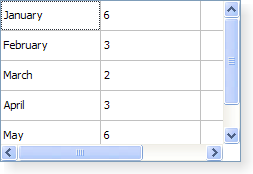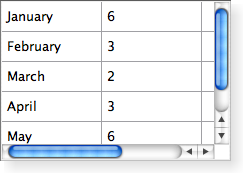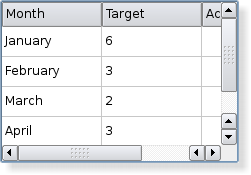| Home · All Classes · Modules |
The QTableWidget class provides an item-based table view with a default model. More...
Inherits QTableView.
The QTableWidget class provides an item-based table view with a default model.
Table widgets provide standard table display facilities for applications. The items in a QTableWidget are provided by QTableWidgetItem.
If you want a table that uses your own data model you should use QTableView rather than this class.
Table widgets can be constructed with the required numbers of rows and columns:
tableWidget = new QTableWidget(12, 3, this);
Alternatively, tables can be constructed without a given size and resized later:
tableWidget = new QTableWidget(this);
tableWidget->setRowCount(10);
tableWidget->setColumnCount(5);
Items are created ouside the table (with no parent widget) and inserted into the table with setItem():
QTableWidgetItem *newItem = new QTableWidgetItem(tr("%1").arg(
(row+1)*(column+1)));
tableWidget->setItem(row, column, newItem);
If you want to enable sorting in your table widget, do so after you have populated it with items, otherwise sorting may interfere with the insertion order (see setItem() for details).
Tables can be given both horizontal and vertical headers. The simplest way to create the headers is to supply a list of strings to the setHorizontalHeaderLabels() and setVerticalHeaderLabels() functions. These will provide simple textual headers for the table's columns and rows. More sophisticated headers can be created from existing table items that are usually constructed outside the table. For example, we can construct a table item with an icon and aligned text, and use it as the header for a particular column:
QTableWidgetItem *cubesHeaderItem = new QTableWidgetItem(tr("Cubes"));
cubesHeaderItem->setIcon(QIcon(QPixmap(":/Images/cubed.png")));
cubesHeaderItem->setTextAlignment(Qt.AlignVCenter);
The number of rows in the table can be found with rowCount(), and the number of columns with columnCount(). The table can be cleared with the clear() function.
 |
 |
 |
| A Windows XP style table widget. | A Macintosh style table widget. | A Plastique style table widget. |
The parent argument, if not None, causes self to be owned by Qt instead of PyQt.
Creates a new table view with the given parent.
The parent argument, if not None, causes self to be owned by Qt instead of PyQt.
Creates a new table view with the given rows and columns, and with the given parent.
Returns the widget displayed in the cell in the given row and column.
Note: The table takes ownership of the widget.
This function was introduced in Qt 4.1.
See also setCellWidget().
This method is also a Qt slot with the C++ signature void clear().
Removes all items in the view. This will also remove all selections. The table dimensions stay the same.
This method is also a Qt slot with the C++ signature void clearContents().
Removes all items not in the headers from the view. This will also remove all selections. The table dimensions stay the same.
This function was introduced in Qt 4.2.
Closes the persistent editor for item.
See also openPersistentEditor().
Returns the column for the item.
Returns the column of the current item.
See also currentRow() and setCurrentCell().
Returns the current item.
See also setCurrentItem().
Returns the row of the current item.
See also currentColumn() and setCurrentCell().
Reimplemented from QWidget.dropEvent().
Handles the data supplied by a drag and drop operation that ended with the given action in the given row and column. Returns true if the data and action can be handled by the model; otherwise returns false.
See also supportedDropActions().
Starts editing the item if it is editable.
Reimplemented from QObject.event().
Finds items that matches the text using the given flags.
Returns the horizontal header item for column, column, if one has been set; otherwise returns 0.
See also setHorizontalHeaderItem().
Returns the QModelIndex assocated with the given item.
This method is also a Qt slot with the C++ signature void insertColumn(int).
Inserts an empty column into the table at column.
This method is also a Qt slot with the C++ signature void insertRow(int).
Inserts an empty row into the table at row.
Returns the item for the given row and column if one has been set; otherwise returns 0.
See also setItem().
Returns a pointer to the item at the given point, or returns 0 if point is not covered by an item in the table widget.
See also item().
Returns the item at the position equivalent to QPoint(ax, ay) in the table widget's coordinate system, or returns 0 if the specified point is not covered by an item in the table widget.
See also item().
Returns a pointer to the QTableWidgetItem assocated with the given index.
Returns the item prototype used by the table.
See also setItemPrototype().
Returns a list of pointers to the items contained in the data object. If the object was not created by a QTreeWidget in the same process, the list is empty.
The QMimeData result
Returns an object that contains a serialized description of the specified items. The format used to describe the items is obtained from the mimeTypes() function.
If the list of items is empty, 0 is returned rather than a serialized empty list.
Returns a list of MIME types that can be used to describe a list of tablewidget items.
See also mimeData().
Opens an editor for the give item. The editor remains open after editing.
See also closePersistentEditor().
Removes the widget set on the cell indicated by row and column.
This function was introduced in Qt 4.3.
This method is also a Qt slot with the C++ signature void removeColumn(int).
Removes the column column and all its items from the table.
This method is also a Qt slot with the C++ signature void removeRow(int).
Removes the row row and all its items from the table.
Returns the row for the item.
This method is also a Qt slot with the C++ signature void scrollToItem(const ::QTableWidgetItem*, ::QAbstractItemView::ScrollHint = QAbstractItemView.EnsureVisible).
Scrolls the view if necessary to ensure that the item is visible. The hint parameter specifies more precisely where the item should be located after the operation.
Returns a list of all selected items.
This function returns a list of pointers to the contents of the selected cells. Use the selectedIndexes() function to retrieve the complete selection including empty cells.
See also selectedIndexes().
Returns a list of all selected ranges.
See also QTableWidgetSelectionRange.
The widget argument has it's ownership transferred to Qt.
Sets the given widget to be displayed in the cell in the given row and column, passing the ownership of the widget to the table.
If cell widget A is replaced with cell widget B, cell widget A will be deleted. For example, in the code snippet below, the QLineEdit object will be deleted.
setCellWidget(index, new QLineEdit); ... setCellWidget(index, new QTextEdit);
This function was introduced in Qt 4.1.
See also cellWidget().
Sets the current cell to be the cell at position (row, column).
Depending on the current selection mode, the cell may also be selected.
This function was introduced in Qt 4.1.
See also setCurrentItem(), currentRow(), and currentColumn().
Sets the current cell to be the cell at position (row, column), using the given command.
This function was introduced in Qt 4.4.
See also setCurrentItem(), currentRow(), and currentColumn().
Sets the current item to item.
Unless the selection mode is NoSelection, the item is also be selected.
See also currentItem() and setCurrentCell().
Sets the current item to be item, using the given command.
This function was introduced in Qt 4.4.
See also currentItem() and setCurrentCell().
The item argument has it's ownership transferred to Qt.
Sets the horizontal header item for column column to item.
See also horizontalHeaderItem().
Sets the horizontal header labels using labels.
The item argument has it's ownership transferred to Qt.
Sets the item for the given row and column to item.
The table takes ownership of the item.
Note that if sorting is enabled (see sortingEnabled) and column is the current sort column, the row will be moved to the sorted position determined by item.
If you want to set several items of a particular row (say, by calling setItem() in a loop), you may want to turn off sorting before doing so, and turn it back on afterwards; this will allow you to use the same row argument for all items in the same row (i.e. setItem() will not move the row).
See also item() and takeItem().
The item argument has it's ownership transferred to Qt.
Sets the item prototype for the table to the specified item.
The table widget will use the item prototype clone function when it needs to create a new table item. For example when the user is editing in an empty cell. This is useful when you have a QTableWidgetItem subclass and want to make sure that QTableWidget creates instances of your subclass.
The table takes ownership of the prototype.
See also itemPrototype().
Selects or deselects the range depending on select.
The item argument has it's ownership transferred to Qt.
Sets the vertical header item for row row to item.
See also verticalHeaderItem().
Sets the vertical header labels using labels.
Sorts all the rows in the table widget based on column and order.
Returns the drop actions supported by this view.
See also Qt.DropActions.
The QTableWidgetItem result
Removes the horizontal header item at column from the header without deleting it.
This function was introduced in Qt 4.1.
The QTableWidgetItem result
Removes the item at row and column from the table without deleting it.
The QTableWidgetItem result
Removes the vertical header item at row from the header without deleting it.
This function was introduced in Qt 4.1.
Returns the vertical header item for row row.
See also setVerticalHeaderItem().
Returns the visual column of the given logicalColumn.
Returns the rectangle on the viewport occupied by the item at item.
Returns the visual row of the given logicalRow.
This is the default overload of this signal.
This signal is emitted when the cell specified by row and column has been activated
This function was introduced in Qt 4.1.
This is the default overload of this signal.
This signal is emitted whenever the data of the item in the cell specified by row and column has changed.
This function was introduced in Qt 4.1.
This is the default overload of this signal.
This signal is emitted whenever a cell in the table is clicked. The row and column specified is the cell that was clicked.
This function was introduced in Qt 4.1.
This is the default overload of this signal.
This signal is emitted whenever a cell in the table is double clicked. The row and column specified is the cell that was double clicked.
This function was introduced in Qt 4.1.
This is the default overload of this signal.
This signal is emitted when the mouse cursor enters a cell. The cell is specified by row and column.
This signal is only emitted when mouseTracking is turned on, or when a mouse button is pressed while moving into an item.
This function was introduced in Qt 4.1.
This is the default overload of this signal.
This signal is emitted whenever a cell in the table is pressed. The row and column specified is the cell that was pressed.
This function was introduced in Qt 4.1.
This is the default overload of this signal.
This signal is emitted whenever the current cell changes. The cell specified by previousRow and previousColumn is the cell that previously had the focus, the cell specified by currentRow and currentColumn is the new current cell.
This function was introduced in Qt 4.1.
This is the default overload of this signal.
This signal is emitted whenever the current item changes. The previous item is the item that previously had the focus, current is the new current item.
This is the default overload of this signal.
This signal is emitted when the specified item has been activated
This is the default overload of this signal.
This signal is emitted whenever the data of item has changed.
This is the default overload of this signal.
This signal is emitted whenever an item in the table is clicked. The item specified is the item that was clicked.
This is the default overload of this signal.
This signal is emitted whenever an item in the table is double clicked. The item specified is the item that was double clicked.
This is the default overload of this signal.
This signal is emitted when the mouse cursor enters an item. The item is the item entered.
This signal is only emitted when mouseTracking is turned on, or when a mouse button is pressed while moving into an item.
This is the default overload of this signal.
This signal is emitted whenever an item in the table is pressed. The item specified is the item that was pressed.
This is the default overload of this signal.
This signal is emitted whenever the selection changes.
See also selectedItems() and QTableWidgetItem.isSelected().
| PyQt 4.12.1 for X11 | Copyright © Riverbank Computing Ltd and The Qt Company 2015 | Qt 4.8.7 |